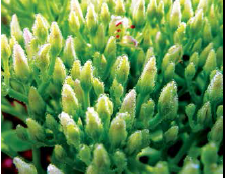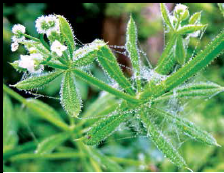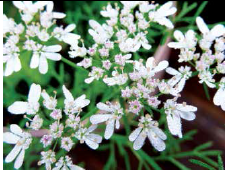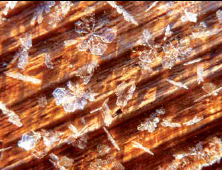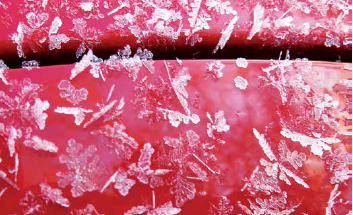As the old adage goes beauty is in the eyes of the beholder. However, certain physical phenomena violate the age old wisdom. For example, who would not find dew drops on a flower to enhance its beauty even more than the flower itself? The present article I have tried to show the beauty of dew drops and frost crystals by taking macro photographs of condensate on various surfaces, flowers, leaves, plants, etc. Regardless of the surface the beauty of these nature’s wonders is always visible.
Basically, in very simple terms dew formation is condensation (nucleation and growth) of perfectly spherical water drops on a surface when relative humidity in the atmosphere is high and the surface cools below dew point due to infra red radiation. Though the nucleation of water drops appears to be at random and yet one finds a nice symmetrical pattern and alignment in the condensation of dew drops. Frost on the other hand forms in solid state and grows in a hexagonal crystal structure shining like diamonds in sunlight. Both are chemically the same (hence I call it having the same “soul”), two hydrogen atom combined with one oxygen atom forming water which is so essential for the life to grow and sustain on our planet. The difference in the physical appearance is obviously due to the ambient temperature – dew forms if the ambient is above the freezing point while frost forms below the freezing point of water.
Dew
Photo1 shows tiny kalanchoe (a succulent plant) buds with dew drops. These buds are about ¼ inch in length and 1/8 inch in diameter, thus the dew drops are very small less than 1mm diameter. This is a macro picture and is enlarged to show the dew drops clearly. This photo and the following photographs were taken in early to mid morning hours since as the ambient temperature rises with the sun both dew and frost evaporate and disappear!!
Photo 2 shows tiny wild weed flowers and leaves with dew drops. Dew drops have also formed on web threads woven by very small spiders. The white flower is about ¼ in across which looks like a giant in comparison to very small dew drops the web. The ambient humidity is very high, about 94% resulting in more dew condensation on the plants.
Photo 3 is that of a coriander (Dhaniya) flower. These flowers are very pretty and again very small. The whole flower cluster is not more than 1 to 1.5 in across with smaller flowers within the cluster. These flowers show beautiful dew drops condensed on them. Some drops are larger than the others indicating these nucleated much before the smaller drops.
Photo 4 is that of a seed pod of a yellow dandelion flower (yes, the same one that we try to eradicate throughout the summer from our lawns). Tiny dew drops form wherever the conditions are right. You can see almost microscopic dew on very thin hair like seed stems. These drops grow with time until meeting the adjoining drop when they could become bigger by coalescence or stay the same if surface tension forces prevent their merger.
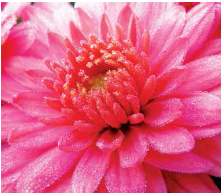
Photo 5
Photo 5 shows a pink mum flower which is totally engulfed by the dew drops. The ambient temperature is about 40 F and 89% humidity. This is a larger flower, about 2 inches in diameter in full bloom.
Frost
As the ambient temperature drops below freezing point (0C/32 F), the water in the atmosphere condenses or nucleates on the surfaces as ice crystals called frost (which is synonymous with “paala” in North India, when it gets extremely cold below the freezing point and frost falls, people say “kal raat ko paala pad gayaa”). The ice crystals have a hexagonal close-packed arrangement of water molecules. The close up macro photos of the frost crystals appear like diamonds from the sky that fell overnight. Here are a few photos of the frost.
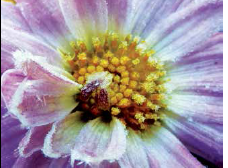
Photo 6
Photo 6 shows frost on mum flowers. Unlike most of the plants these flowers are pretty resistant to the frost damage for the first few times and after that they die of cold. One can see needle like frost crystals growing on the mums.
The crystalline structure of these frost ice crystals is clearly seen in Photo 7 (above) where frost has grown on a wooden table. The size of these crystals is about the size of rice or wheat grains, 1/8 to ¼ in. These really seem like diamonds fallen out of the sky. The photo also shows shadows of these tiny crystals on the table due to the sunlight from rising sun.
Photo 8 (above) shows frost crystals formed on a red car body. It was extremely cold on this day, about 0F (- 17C) with about 80% humidity. These crystals are some what larger about ¼ to 3/8 in. The crystals seem to grow almost in two dimension as seen from the top view looking like a needle while others growing at an angle or horizontally show hexagonal type structure.

Photo 9
Photo 9 (above) shows frost crystals growing on a dried fallen leaf (about 1 to 2 inches in size) on the ground. The temperature and humidity were 20F and 73% respectively.
Nature’s magic is available to see almost every day as seen from the preceding photographs and one must enjoy it as often as possible!!
